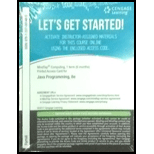
Explanation of Solution
a.
Program code:
Student.java
//define a class Student
class Student
{
//declare the class members
private String ID;
private int numberOfCredits;
private int points;
private double gradePoint;
//define the constructor
public Student()
{}
//define the constructor
public Student(String aID, int aNumberOfCredits, int aPoints)
{
//initialize the class members
super();
ID = aID;
numberOfCredits = aNumberOfCredits;
points = aPoints;
//call the method calculateGradePoint()
calculateGradePoint();
}
//define the method getID()
public String getID()
{
//return the value of ID
return ID;
}
//define the method setID()
public void setID(String aID)
{
//set the value of ID
ID = aID;
}
//define the method getNumberOfCredits()
public int getNumberOfCredits()
{
//return the value of numberOfCredits
return numberOfCredits;
}
//define the method setNumberOfCredits()
public void setNumberOfCredits(int aNumberOfCredits)
{
//set the value of numberOfCredits
numberOfCredits = aNumberOfCredits;
}
//define the method getPoints()
public int getPoints()
{
//return the value of points
return points;
}
//define the method setPoints()
public void setPoints(int aPoints)
{
//set the value of points
points = aPoints;
}
//define the method toString()
public String toString()
{
//return the value
return "ID : " + ID + " NumberOfCredits : " + numberOfCredits + " Points : " + points+" Grade Point : "+gradePoint;
}
//define the method calculateGradePoint()
public void calculateGradePoint()
{
//calculate the value of gradePoint
gradePoint=points/(double)numberOfCredits;
}
}
Explanation:
The above snippet of code is used create a class “Student”. The class contain different static methods for store the details of a student. In the code,
- Define a class “Student”
- Define the constructor “Student ()” method.
- Define the constructor “Student ()” method.
- Initialize the class members.
- Call the method “calculateGradePoint()”.
- Define the “getID()” method.
- Return the value of the variable “ID”.
- Define the “setID()” method.
- Set the value of the variable “ID”.
- Define the “getNumberOfCredits()” method.
- Return the value of the variable “NumberOfCredits”...
Trending nowThis is a popular solution!

Chapter 3 Solutions
Mindtap Computing, 1 Term (6 Months) Printed Access Card For Farrell’s Java Programming, 8th
- using r languagearrow_forwardusing r languagearrow_forwardWrite a short paper (1 page/about 500 words) summarizing what we as System Admins can do to protect the CIA of our servers. Outline the overall steps for configuring and securing Linux servers Consider and describe how a mixed Operating System environment will affect what you have to do to protect the company assets Describe at least three technologies that will help to protect CIA of data on Linux systems Required Resourcesarrow_forward
- using r language Estimate the MSE of the level k trimmed means for random samples of size 20 generated from a standard Cauchy distribution. (The target parameter θis the center or median; the expected value does not exist.) Summarize the estimates of MSE in a table for k= 1,2,...,9arrow_forwardusing r language Estimate the MSE of the level k trimmed means for random samples of size 20 generated from a standard Cauchy distribution. (The target parameter θis the center or median; the expected value does not exist.) Summarize the estimates of MSE in a table for k= 1,2,...,9arrow_forwardusing r language The data law82 in bootstrap library contains LSAT and GPA for 82 law schools. Compute a 95% bootstrap t confidence interval estimates for the correlation statisticsarrow_forward
- using r language The data law82 in bootstrap library contains LSAT and GPA for 82 law schools. Compute a 95% bootstrap t confidence interval estimates for the correlation statisticsarrow_forwardusing r langauge The data law82 in bootstrap library contains LSAT and GPA for 82 law schools. Compute and compare the three 95% bootstrap confidence interval estimates for the correlation statistics.arrow_forwardWhat is the number of derangements of size k from the set {1,2,...n} to the set {1,2,...n} so that f(x) != x exactly k times with 1 <= k <= narrow_forward
- Trace a State Space Tree introduced in the Chapter 5.1 using algorithms depth_first_search (page 205), checknode (page 207), and expand (page 210). Assume that State Space Tree is a two-level full binary tree (root is level 0). Node #2 (according to notation used in the Figure 5.1, page 204) is non-promising. Count the number of steps performed by each of those three algorithms. Consider execution of instructions like "visit node" or execution of "promising function" as one step, "write a solution" as an exit call. Note: no need to print or a draw a whole tree. Just provide three numbers as an answerarrow_forwardParking Tickets Table St ID L_Name ☐ F_Name Phone_No St_Lic Lic_No Ticket# Date Code Fine 38249 38249 82453 Green 82453 Green 82453 Green Brown Thomas 111-7804 FL BRY 123 15634 10/17/06 2 $25 Brown Thomas 111-7804 FL BRY 123 16017 11/13/06 1 $15 Sally 391-1689 AL TRE 141 14987 10/05/06 3 $100 Sally 391-1689 AL Sally 391-1689 AL TRE 141 TRE 141 16293 11/18/06 1 $15 17892 12/13/06 2 $25 The functional dependencies are: St_ID → L_Name, F_Name, Phone_No, St_Lic, Lic_No St_Lic → Lic_No Code → Fine St_ID, Ticket # → Date 1. In what normal form is the relation?| 2. Convert PARKING TICKET to a set of 3NF relations.arrow_forwardIn excel, What does sorting mean? In excel, What does filtering mean? What are three advantages of converting a range in Excel to a table and List the steps involved in creating a table in Excel if you were using the range A7:G34arrow_forward
 Microsoft Visual C#Computer ScienceISBN:9781337102100Author:Joyce, Farrell.Publisher:Cengage Learning,
Microsoft Visual C#Computer ScienceISBN:9781337102100Author:Joyce, Farrell.Publisher:Cengage Learning, EBK JAVA PROGRAMMINGComputer ScienceISBN:9781337671385Author:FARRELLPublisher:CENGAGE LEARNING - CONSIGNMENT
EBK JAVA PROGRAMMINGComputer ScienceISBN:9781337671385Author:FARRELLPublisher:CENGAGE LEARNING - CONSIGNMENT EBK JAVA PROGRAMMINGComputer ScienceISBN:9781305480537Author:FARRELLPublisher:CENGAGE LEARNING - CONSIGNMENT
EBK JAVA PROGRAMMINGComputer ScienceISBN:9781305480537Author:FARRELLPublisher:CENGAGE LEARNING - CONSIGNMENT- Programming Logic & Design ComprehensiveComputer ScienceISBN:9781337669405Author:FARRELLPublisher:Cengage
 Programming with Microsoft Visual Basic 2017Computer ScienceISBN:9781337102124Author:Diane ZakPublisher:Cengage Learning
Programming with Microsoft Visual Basic 2017Computer ScienceISBN:9781337102124Author:Diane ZakPublisher:Cengage Learning C++ Programming: From Problem Analysis to Program...Computer ScienceISBN:9781337102087Author:D. S. MalikPublisher:Cengage Learning
C++ Programming: From Problem Analysis to Program...Computer ScienceISBN:9781337102087Author:D. S. MalikPublisher:Cengage Learning





